An accurate assessment of nutrient content is also needed to determine the cost per pound of energy (e.g. TDN) and protein supplied.
Round bales are generally described by bale width × bale diameter or bale height. For example, a 5’ × 6’ bale would be five feet wide and six feet in diameter and a 4’ × 5’ bale would be four feet wide and five feet in diameter.

Table 1 shows the effect that bale size has on bale weight by using a 5’ × 5’ bale that weighs 1,100 pounds for comparison; this bale would have a density of 11.21 pounds per cubic foot.
If all bales had the same density, those of varying sizes would range in weight from 563 to 1,584 pounds. Table 1 also illustrates the percentage difference among various sizes of bales.
• A 4’ × 4’ bale is only 51 percent the size of a 5’ × 5’ bale.
• A 5’ × 6’ bale is 44 percent larger than a 5’ × 5’ bale.
In addition to size, bale density also has a major impact on bale weight. Density as influenced by tightness of wrap or bale compression can vary considerably, depending on operator preference and the equipment being used.
Most balers have a range of settings that allow the operator to increase or decrease wrap tightness and bale compression. Also, some balers can compress more tightly than can standard equipment; these types of balers are generally used for baling low-density forages like wheat straw.
Another factor affecting bale density is that some forages are naturally denser than others. Both plant maturity and forage species influence forage density.
As plants mature, the neutral detergent fiber (NDF) content generally increases, which reduces density. Consequently, hay produced from young immature bermudagrass is denser than hay from mature bermudagrass.
Differences in forage species also affect density; for example, alfalfa is typically denser than bermudagrass and bermudagrass is denser than wheat straw.
Instead of price per bale, hay should be purchased by the ton. The importance of pricing hay by the ton is illustrated in Table 1. The last column shows what the price per ton would be if all bales – regardless of weight – were priced at $50 each.
The 1,100-pound bales would cost $90.91 per ton ($50 ÷ 1,100 pounds = $0.04545 per pound; 2,000 pounds × $0.04545 per pound = $90.91 per ton). In comparison, the 563-pound bales would cost $177.56 per ton.
In addition to cost per ton, the cost per pound of energy (e.g. TDN) and protein should be calculated. To determine nutrient content each load or cutting of hay should be sampled and sent to a reputable lab for testing.
The most appropriate analysis will depend on forage species, intended use and laboratory experience, so producers should consult with a nutritionist for specific testing recommendations.
Reputable labs will report nutrient concentration on both an as-fed and dry matter basis. For example, a lab may report that a sample contains 10 percent moisture, 52.2 percent TDN on an as-fed basis and 58.0 percent TDN on a dry matter basis.
Values reported on an as-fed basis are handy when calculating cost per pound of nutrient and values reported on a dry matter basis are useful when evaluating animal nutrient requirements.
The cost per pound of nutrient can be determined with the following equations:
1. 2,000 pounds x percentage of nutrient on an as-fed basis = pound of nutrient per ton
2. cost per ton of hay ÷ pound of nutrient per ton = cost per pound of nutrient.
For example, if a load of hay cost $130 per ton and contained 52.2 percent TDN on an as-fed basis, the cost per pound of TDN would be $0.125 as shown below:
• 2,000 pounds x 52.2 percent TDN = 1,044 pounds of TDN
• $130 ÷ 1,044 pounds of TDN = $0.125 per pound of TDN
These equations can be used to calculate the cost per unit of TDN, protein or any nutrients found in hay as well as other feedstuffs and supplements.
Depending on nutrient content and price per ton it may be cheaper to purchase hay that is slightly more expensive per ton but has a higher nutrient content.
Calculating cost per pound of nutrient will allow for the selection of more economical sources of hay, resulting in reduced feeding and supplementation costs.
Additionally, forage condition (free of mold, foreign objects and weeds), forage species, the potential presence of toxic compounds (such as nitrates), palatability, storage characteristics and potential feeding losses should be considered when selecting hay and evaluating its value. FG
PHOTO
Calculating cost per pound of nutrient will allow for the selection of more economical sources of hay, resulting in reduced feeding and supplementation costs. Photo courtesy of FG staff.













